
advertisements
Dracula and the Eye of Medusa
And so veteran actor Anthony Hopkins – in his role as the vampire hunter Professor Van Hesling – explains the supernatural power of Dracula and the challenge of pursuing him to that mythical vampire sanctuary, Transylvania.
In this 1992 film directed by Francis Ford Coppola, Hopkins plays alongside Gary Oldman as Dracula, Wynona Ryder as Mina (Dracula's love interest), Keanu Reeves as Jonathan Harker (Mina's fiancé), and Sadie Frost as Lucy (Mina's best friend). These are the story's main characters, which for the last century in hundreds of literary, cinematic and theatrical versions have horrified us with their eerie plot twists and psychosexual allegories.
Coppola's Bram Stoker's Dracula was a huge box office hit, grossing some $215 million worldwide, and by far the most commercially successful adaptation of the book to date. The only Dracula film with a similar mass appeal was the original 1931 film starring Bela Lugosi, which likewise sent audiences home with chills and nightmares. Cinematically, there's no comparison. Lugosi's performance was so melodramatic and frightening (at the time), that he became the iconic Dracula. But the production was low budget and appeared right after the advent of sound, so that the filming technique was stiff and narrative. Coppola's version soars with intensely erotic fantasy scenes, and following Coppola's preferred style, is a blood-filled visual spectacle. The film won three Academy Awards for Best Costume, Best Sound Effects, and Best Makeup, but in televised and many theatrical releases it was heavily censored to shield mainstream audiences from the gore and sex.
The story and character of Dracula became an immediate cultural phenomenon when it was first published by Bram Stoker in 1897, and has remained immensely popular ever since. The Internet Movie Database tells us that over 200 films have been made that feature Count Dracula, with several hundred more that have vampires as their subject. Only Sherlock Holmes has been in more movies. Thousands of novels have been written about Dracula, who is also found in hundreds of cartoons, comics, and television programs. The most recent vampire success story was Twilight, with the film version grossing over $382 million worldwide. However, Twilight was based on the novel by the Mormon writer Stephenie Meyer, who saw the basic plot outline in a dream that came to her on June 2, 2003. Compared to Coppola's shocking storyline, Twilight is a bland teen romance, but made edgy enough with the simple inclusion of a vampire.
"Vampires do exist. This one we fight, this one we face, has the strength of 20 or more people. And you can testify to that Mr. Harker. And he can also control the meaner things of life, the bat, the rodent, the wolf. He can appear as mist, as vapor, as fog, and vanish at will. And all these things Dracula can do, but he is not free. He must rest in the sacred earth of his homeland to gain his evil power. It is here that we must find him and destroy him utterly."
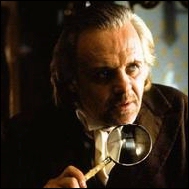
NeptuneCafe presents
Dracula is a multidimensional myth exposing and exorcizing spiritual, social, moral and political flaws. As each generation following Bram Stoker created their own version of Dracula, we learn that every age embraces the Dracula that it needs.

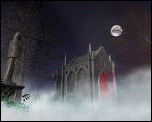
Dracula's Horoscope
The astrology of Dracula begins with Bram Stoker's first public reading of his novel on May 18, 1897. I was surprised to find the exact time of this reading on the internet, which you can also do by going to amazon.com's website and looking up The Mammoth Book of Dracula. You can read the book's first page, which gives the time of 10:15 am. The place is set for London. Using this data, we have a horoscope for the popular legend of Dracula, which can be used to better understand the multidimensional dynamics of the various characters, and the cultural evolution of the Dracula archetype through the years.
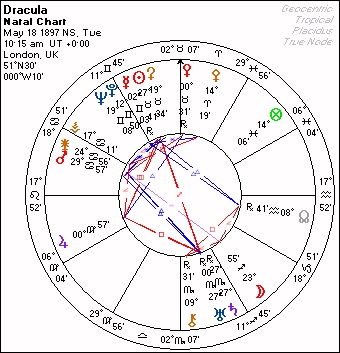
With dramatic Leo Rising, the Sun is the ruler of this chart. The Sun is found at 27º Taurus where it forms an exact opposition to a Saturn-Uranus conjunction at 27º Scorpio. This configuration represents Count Dracula himself – he is the central character around which all the action takes place, like the Sun is the center of the solar system. It can also describe the essential conflicts that drive the story forward. Saturn and Uranus are natural enemies: Saturn represents the old, traditional way of doing things, while Uranus urges us on toward the future, with progressive ideas and new technologies. A central theme of Dracula is how old superstitions and the shadowy, evil world of the antagonist are overcome by knowledge, technology, and light. Dracula must sleep during the day, and the heroes eventually track him down and manage to kill him just before sunset.
Dracula's character has many of the traits associated with the Sun in Taurus. Like Dracula, those with a Taurus Sun are strengthened by their ties to the physical earth. Dracula's sense of security is rooted in his homeland of Transylvania. In the novel and in the 1931 film, Dracula goes to England with caskets full of Transylvanian soil, where he must rest during the day to regain his strength. The Taurus Sun might also describe Dracula's financial security, which is evident in his huge (if not creepy) castle. Like the Taurus native, Dracula has good taste in food and dress. The dark black cape worn by Bela Lugosi is replaced by a papal scarlet cape in Coppola's film, but in both cases, they evoke theatric flair and hidden power. He is a connoisseur of fine wines: when Jonathan Harker first visits him in the story's opening scenes, he is offered an aged wine. This scene is replicated in both the 1931 and 1992 films. Dracula responds by saying " I do not drink... (dramatic pause) ... wine."
Is there evil in the world? Does evil actually exist?
Astrologically, an enduring legacy of evil is associated with Algol, a binary star located at 26º Taurus. Algol is situated in the constellation of Perseus, which depicts the Greek hero holding the decapitated head of Medusa. The gorgon Medusa could turn her enemies to stone with one look, but in the myth, Perseus managed to track and kill her by looking at her image reflected in his bronze shield. Algol represents Medusa's evil eye, which appears to blink every three days when the dimmer star of this binary system passes in front of the brighter star.
In Dracula's horoscope, the Sun is conjunct Algol. Here we have the connection to the evil power that is captured in the dramatization.
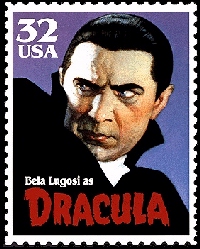
The Taurus Sun is informed by the two competing archetypes Saturn and Uranus, which are conjunct in the sexually-oriented sign of Scorpio. Here we have the underlying motivation for Count Dracula, who must deal with his blood lust without drawing too much attention to himself. In Victorian times, ordinary people were also vaguely aware of their underlying sexual desires, but had to
conceal them for fear of being ostracized or labeled as perverts. Uranus in Scorpio is sexually liberating, but only under the cover of darkness could anyone feel safe enough to express this. Saturn in Scorpio symbolized the order of the day, which was to not speak of such things and to keep a tight lid on sexual impulses.
Saturn in Scorpio can symbolize sexual inhibition and repression, which was the over-riding zeitgeist of Bram Stoker's era, widely known as the Victorian Age. In the same way, Dracula presented himself in the daytime as a charming, classy character with good taste. But at night he sucked the blood of his victims in order to nourish his vitality. The exchange of bodily fluids was only a thin disguise for what the story was really about. But it spoke to the subconscious mind. Consciously, most audiences were happy to be horrified by a gothic tale of supernatural evil.  .
.
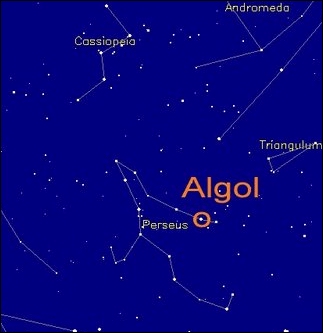
Since ancient times, cultures around the world separated by impassable land masses and yet-to-be developed technology, all found Algol to be an evil presence in the heavens. In ancient China, this star was called Tseih She, which means "piled-up corpses". In Hebrew mythology this star is known as "Satan's Head", and in most star book interpretations Algol is associated with violence, death and decapitation. It's also associated with drunkenness, since Algol is directly related to the word "alcohol", and "losing one's head" in the metaphorical sense, or in its extreme form, going insane.
In modern times it's said to carry the collective rage for the suppression of female power. This is derived from the Hebrew association of Algol with Lilith, Adams' first wife, and in the ancient Hebrew culture, Algol was known as Lilith. One of Lilith's dreaded past-times was to steal the children of Adam's second wife Eve and the children of all her descendants. In Dracula, after Lucy becomes a vampire, she becomes obsessed with stealing children. Did Bram Stoker know of these connections, or was he unwittingly channeling the mythology of Algol?
In Dracula's horoscope, the Sun (the ruler of the chart) is conjunct Algol. Here we have the connection to the evil power that is captured in the dramatization. Dracula is evil, he is Satan's representative on earth, he is everything that we fear. He tempts his victims with promises of power, while all the time he is just a bloodsucking vampire. If we can move beyond the Judeo-Christian concepts of good and evil, he represents the shadowy power of repressed sexuality.
The material on this page is excerpted from a full-length article on Dracula, published in Dell Horoscope's November 2009 issue.

Click here to add text.